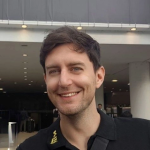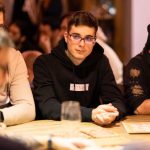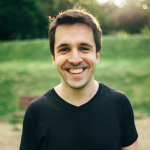Game Dev Day 2025 Sessions
- Each session description has a flag indicating its language. This year, half of the performances will be in English.
- You can switch between hall schedules by clicking on the hall names.
Megnyitó

TÖRÖLVE - Design Vízió
Adam Barnes
![]() Sajnos Adam betegség miatt le kellett, hogy mondja az előadást - Egy áttekintés arról, hogyan segíti a játékfejlesztés korai szakaszában meghatározott világos vízió a játék magjának megtervezését, a méret túlburjánzás (scope creep) elkerülését, valamint hogyan járulhat hozzá a kiadók és maguk a játékosok megnyeréséhez.
Sajnos Adam betegség miatt le kellett, hogy mondja az előadást - Egy áttekintés arról, hogyan segíti a játékfejlesztés korai szakaszában meghatározott világos vízió a játék magjának megtervezését, a méret túlburjánzás (scope creep) elkerülését, valamint hogyan járulhat hozzá a kiadók és maguk a játékosok megnyeréséhez.

The Advantages of Deterministic Gameplay
Dominik Kovács
![]() This talk focuses on the concept of determinism and its critical importance in games, both for gameplay and technical reliability. It explains what determinism means in the context of different game systems—where the same input always produces the same output—and why it is essential for multiplayer synchronization, replay and fast-forward systems, procedural generation, as well as debugging and QA.
The presentation also covers the consequences of non-deterministic code, such as desynchronization errors in multiplayer games and hard-to-reproduce bugs. Best programming practices for achieving and maintaining determinism, along with the challenges and common pitfalls to avoid, will be discussed. Examples of popular games that rely fully on determinism, the issues encountered during their development, and the lessons learned will also be highlighted.
Említésre kerülnek népszerűbb játékok amik teljesen a determinizmusra támaszkodnak, azok fejlesztése során felmerült problémák és tanulságok.
This talk focuses on the concept of determinism and its critical importance in games, both for gameplay and technical reliability. It explains what determinism means in the context of different game systems—where the same input always produces the same output—and why it is essential for multiplayer synchronization, replay and fast-forward systems, procedural generation, as well as debugging and QA.
The presentation also covers the consequences of non-deterministic code, such as desynchronization errors in multiplayer games and hard-to-reproduce bugs. Best programming practices for achieving and maintaining determinism, along with the challenges and common pitfalls to avoid, will be discussed. Examples of popular games that rely fully on determinism, the issues encountered during their development, and the lessons learned will also be highlighted.
Említésre kerülnek népszerűbb játékok amik teljesen a determinizmusra támaszkodnak, azok fejlesztése során felmerült problémák és tanulságok.
Opportunities for Indie Game Development in Hungary
![]() Dániel Prokisch (Quest Lab, Havi Egy Játék), Zsolt Várady (The Wild Gentlemen), and András Fórizs (Quest Lab) will discuss the opportunities and career paths available to aspiring indie game developers in Hungary.
Dániel Prokisch (Quest Lab, Havi Egy Játék), Zsolt Várady (The Wild Gentlemen), and András Fórizs (Quest Lab) will discuss the opportunities and career paths available to aspiring indie game developers in Hungary.

Hogyan segítheti a kreatívipari szemlélet a játékfejlesztők munkáját?
Jakab Zsófia
Jakab Zsófia, kreatívipar fejlesztéséért és ágazati koordinációjáért felelős miniszteri biztos, a Magyar Divat & Design Ügynökség vezérigazgatója előadásában bemutatja, hogy a jövőben milyen lehetőségekkel és új programokkal tervezi támogatni a Magyar Divat & Design Ügynökség a hazai játékipar fejlődését. Az előadás rávilágít arra, hogyan találkozhat a játékfejlesztés a design, a szépségipar és a kreatívipar.
Lunch Break

From Intellectual Property to Loot Boxes: The Legal Minefield of Game Development
Zsolt Tolnai
![]() The development and distribution of modern video games raises many legal questions: who actually owns the game and the embedded content, what legal framework does the developer, the artist, the studio, the publisher, the platform, the streamer, the modder and the player operate within? The presentation touches on the legal risks lurking for novice game developers, the issue of enforcement and applicable law, as well as the legal status of AI-generated content. These and other current dilemmas will be explored by Zsolt Tolnai, the head of the TLF office, and his colleagues, attorney Balázs Kun and candidate attorney Richárd Tarján.
The development and distribution of modern video games raises many legal questions: who actually owns the game and the embedded content, what legal framework does the developer, the artist, the studio, the publisher, the platform, the streamer, the modder and the player operate within? The presentation touches on the legal risks lurking for novice game developers, the issue of enforcement and applicable law, as well as the legal status of AI-generated content. These and other current dilemmas will be explored by Zsolt Tolnai, the head of the TLF office, and his colleagues, attorney Balázs Kun and candidate attorney Richárd Tarján.

From Idea to Player: Quest Design in Elder Scrolls Online
Viktória Fehér
![]() Focus on quest design. We'll show you a specific quest and see how a quest is made in Elder Scrolls Online from the idea to the moment it reaches the players, while also showing you what an update looks like for us as a quest designer.
Focus on quest design. We'll show you a specific quest and see how a quest is made in Elder Scrolls Online from the idea to the moment it reaches the players, while also showing you what an update looks like for us as a quest designer.

Releasing an Indie Game: Steam Visibility and Algorithms
Patrik Nagy
![]() How does a good game become a real success? This talk offers insight into why developing a good game alone isn’t enough, and how a well-crafted Steam page and understanding the platform’s algorithm can help your game stand out from the crowd. We’ll cover common mistakes indie developers make, how the Steam algorithm actually works, and which elements — from images to descriptions — are key to reaching the largest possible audience for your game.
How does a good game become a real success? This talk offers insight into why developing a good game alone isn’t enough, and how a well-crafted Steam page and understanding the platform’s algorithm can help your game stand out from the crowd. We’ll cover common mistakes indie developers make, how the Steam algorithm actually works, and which elements — from images to descriptions — are key to reaching the largest possible audience for your game.
Pitch verseny
teszt

Death to Paper Design: Workflows, Tools and Iteration in Level Design
Nicolás Tornatti Ceballos
![]() Level design today is less about following fixed steps and more about balancing creativity with practicality, ensuring that workflows support, rather than limit the outcome of our work. It’s about finding smarter, more fluid ways to bring game worlds to life and not waste time in pointless or inefficient tasks. In this talk, I won’t present the ultimate solution for success, but I will rather share insights from my experience to shed some light on this constantly evolving world that is level design.
Level design today is less about following fixed steps and more about balancing creativity with practicality, ensuring that workflows support, rather than limit the outcome of our work. It’s about finding smarter, more fluid ways to bring game worlds to life and not waste time in pointless or inefficient tasks. In this talk, I won’t present the ultimate solution for success, but I will rather share insights from my experience to shed some light on this constantly evolving world that is level design.
Lunch Break

Lots of Objects, Not Enough Time: Practical Use of Acceleration Structures
Dániel Berényi
![]() In graphics, game development, and many other math-intensive fields, we frequently encounter tasks that require searching or comparing large numbers of objects based on their spatial relationships. Examples include collision detection in physics engines and visibility determination when rendering complex scenes.
This talk will cover examples ranging from simple to complex, highlighting the inefficiencies of naive approaches and demonstrating how acceleration structures can help. We’ll also explore problems that still require creative solutions beyond standard techniques.
In graphics, game development, and many other math-intensive fields, we frequently encounter tasks that require searching or comparing large numbers of objects based on their spatial relationships. Examples include collision detection in physics engines and visibility determination when rendering complex scenes.
This talk will cover examples ranging from simple to complex, highlighting the inefficiencies of naive approaches and demonstrating how acceleration structures can help. We’ll also explore problems that still require creative solutions beyond standard techniques.
Leveling Up: Challenges and Benefits of Growing Your Studio
![]() This panel discussion explores the obstacles, risks, and new challenges that come with growing a game development studio. We’ll also examine how company operations and creative processes change during expansion, as well as the benefits growth can bring—not just for the studio itself, but also for the broader local industry and economy.
This panel discussion explores the obstacles, risks, and new challenges that come with growing a game development studio. We’ll also examine how company operations and creative processes change during expansion, as well as the benefits growth can bring—not just for the studio itself, but also for the broader local industry and economy.

Art Direction and Worldbuilding in Fabular
Péter Meszlényi
![]() How do you build a world from a single idea? How do visual tools support the content? When does the imagery itself become the story? Is the essence in the details? Péter Meszlényi explores these questions, while also covering illustration, concept art, and art direction.
How do you build a world from a single idea? How do visual tools support the content? When does the imagery itself become the story? Is the essence in the details? Péter Meszlényi explores these questions, while also covering illustration, concept art, and art direction.

Concept Art and Visual Design in the Entertainment Industry
János Gárdos
![]() In this talk, János will introduce the workings and structure of Pixoloid Studio and provide insight into their daily workflows. He will discuss how the studio gets involved at different stages of production, how they communicate with clients, and showcase concrete examples of how they tackle various visual design challenges.
In this talk, János will introduce the workings and structure of Pixoloid Studio and provide insight into their daily workflows. He will discuss how the studio gets involved at different stages of production, how they communicate with clients, and showcase concrete examples of how they tackle various visual design challenges.

UI material creation: texture-based or procedural and SDF-based approach?
Róbert Haáb
![]() Both approaches have their advantages and disadvantages – it depends on the problem you are trying to solve. We will now look at the topic through UI examples, but these principles can be easily transferred to other areas. As an addition, we will also delve a little into the world of SDF (Signed Distance Field): how to create shapes in shaders based on pure mathematics – without textures, pixel-precise.
Both approaches have their advantages and disadvantages – it depends on the problem you are trying to solve. We will now look at the topic through UI examples, but these principles can be easily transferred to other areas. As an addition, we will also delve a little into the world of SDF (Signed Distance Field): how to create shapes in shaders based on pure mathematics – without textures, pixel-precise.

Custom Game Engines - The Promised Land of Pet Projects
Mateusz Szymoński
![]() Building a custom game engine may sound like madness — it’s complex, time-consuming, and touches nearly every branch of computer science.
Why would anyone spend months (or years) building their own engine instead of just making a game? In this talk, Mateusz Szymoński — technical artist at CD PROJEKT RED and co-founder of Sticky Piston Studios — shares why homegrown engines are the ultimate playground for curious makers. From endless opportunities to learn and create, to the “wow factor” of showing off your own tech, discover how custom game engine can become a magnum opus for the right kind of developer.
Building a custom game engine may sound like madness — it’s complex, time-consuming, and touches nearly every branch of computer science.
Why would anyone spend months (or years) building their own engine instead of just making a game? In this talk, Mateusz Szymoński — technical artist at CD PROJEKT RED and co-founder of Sticky Piston Studios — shares why homegrown engines are the ultimate playground for curious makers. From endless opportunities to learn and create, to the “wow factor” of showing off your own tech, discover how custom game engine can become a magnum opus for the right kind of developer.
Lunch Break

Life at Astra Virtual Studio – The future of filmmaking up close
Zubán Dániel Rafael
![]() Rafael az előadásában feltárja, hogyan zajlik a filmgyártás virtuális környezetben: a LED-falas autós jelenet felvételétől a nagyobb filmes LED setupokig - a stúdió életen át egészen a színészek reakciójáig. Továbbá ad egy izgalmas betekintést az Unreal jelenlegi produkciós megítélésébe és a filmipari elvárásokba, illetve különböző kijátszási technológiákba. Unreal Engine, Chaos Arena, Pixera, stb.
Rafael az előadásában feltárja, hogyan zajlik a filmgyártás virtuális környezetben: a LED-falas autós jelenet felvételétől a nagyobb filmes LED setupokig - a stúdió életen át egészen a színészek reakciójáig. Továbbá ad egy izgalmas betekintést az Unreal jelenlegi produkciós megítélésébe és a filmipari elvárásokba, illetve különböző kijátszási technológiákba. Unreal Engine, Chaos Arena, Pixera, stb.

Beyond the Basics: Making Your Game Sound Amazing in Unreal Engine
Zsombor Bencsik
![]() Sound is one of the most powerful pillars of the gaming experience — but how can you create a truly professional, immersive audio experience in Unreal Engine? This talk offers practical tips and proven techniques to elevate the sound design of your project. Topics include sourcing and editing high-quality sound effects, dialogue, and music, setting up submixes and sound classes correctly, and implementing spatial effects like reverb efficiently. You’ll also get an introduction to the possibilities of Metasound, as well as best mixing practices — from balancing audio levels to applying ducking.
Sound is one of the most powerful pillars of the gaming experience — but how can you create a truly professional, immersive audio experience in Unreal Engine? This talk offers practical tips and proven techniques to elevate the sound design of your project. Topics include sourcing and editing high-quality sound effects, dialogue, and music, setting up submixes and sound classes correctly, and implementing spatial effects like reverb efficiently. You’ll also get an introduction to the possibilities of Metasound, as well as best mixing practices — from balancing audio levels to applying ducking.

Lightning-Fast Iteration in Unreal Engine with script languages
Ádám Fülöp
![]() Unreal Engine traditionally offers two scripting options: C++ and Blueprints. C++ can lead to slow iteration and numerous potential errors, while Blueprints can be hard to manage and less programmer-friendly. AngelScript provides a middle ground between the two: it enables fast and safe development while retaining all the benefits of text-based coding. In this talk, we’ll explore when to choose C++, Blueprints, or AngelScript, review the scripting languages currently available for Unreal Engine, and take a closer look at the fundamentals of AngelScript.
Unreal Engine traditionally offers two scripting options: C++ and Blueprints. C++ can lead to slow iteration and numerous potential errors, while Blueprints can be hard to manage and less programmer-friendly. AngelScript provides a middle ground between the two: it enables fast and safe development while retaining all the benefits of text-based coding. In this talk, we’ll explore when to choose C++, Blueprints, or AngelScript, review the scripting languages currently available for Unreal Engine, and take a closer look at the fundamentals of AngelScript.

Introduction to World Partition in Unreal
Ádám Bánóczki
![]() In this talk, we’ll explore why Unreal Engine introduced the new World Partition system for building worlds. How does this approach differ from the old one, how does it work, and what advantages does it offer over Sublevels? I’ll show you how this method divides the world into cells, and finally, we’ll look at how to fine-tune level streaming. cellákra a világot ez az új módszer. Végezetül pedig megnézzük, miként tudjuk finomhangolni a pályarészek betöltését.
In this talk, we’ll explore why Unreal Engine introduced the new World Partition system for building worlds. How does this approach differ from the old one, how does it work, and what advantages does it offer over Sublevels? I’ll show you how this method divides the world into cells, and finally, we’ll look at how to fine-tune level streaming. cellákra a világot ez az új módszer. Végezetül pedig megnézzük, miként tudjuk finomhangolni a pályarészek betöltését.
